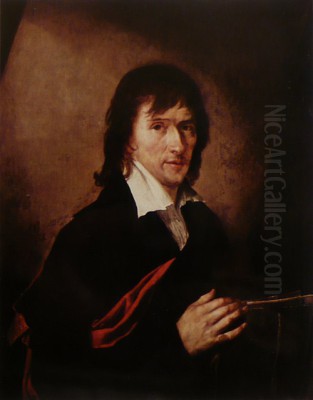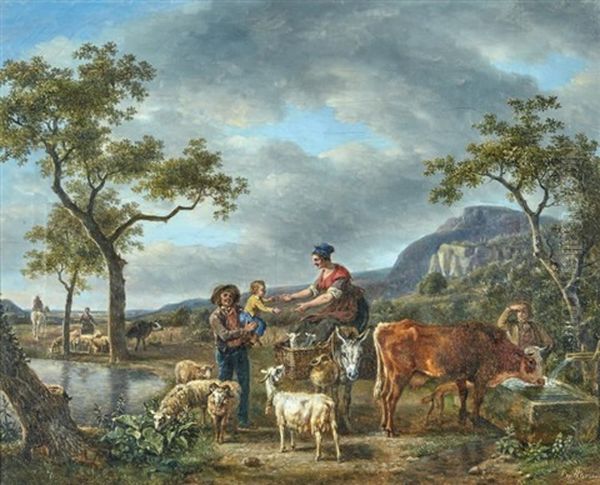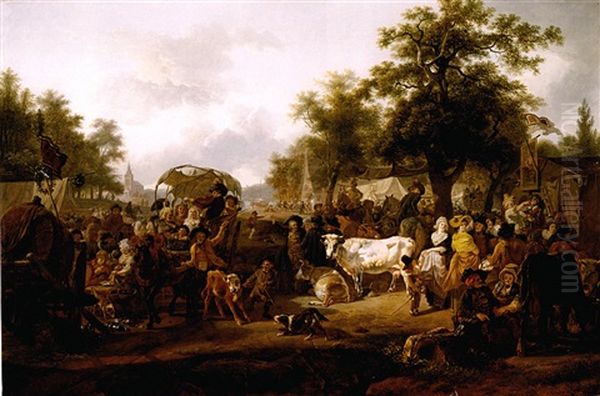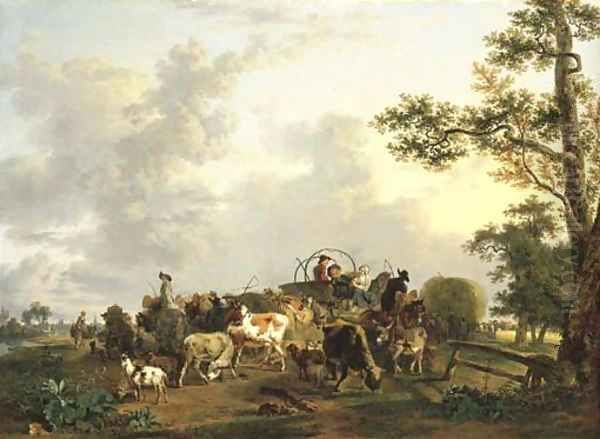
Jean-Louis de Marne stands as a significant figure in French painting during the transition from the late 18th to the early 19th century. Often noted for the precise spelling of his name, Jean-Louis de Marne (distinct from the occasional misspelling "Demarne"), he carved a niche for himself through charming genre scenes and meticulously rendered landscapes. Born in Brussels in 1752, his artistic journey led him to Paris, the heart of the European art world, where he developed a style that blended influences from the Dutch Golden Age with contemporary French sensibilities. His long career, ending with his death in 1829, left behind a body of work appreciated for its detail, narrative quality, and enduring appeal.
Early Life and Artistic Formation
Jean-Louis de Marne's story begins in Brussels, then part of the Austrian Netherlands. His initial artistic inclinations were nurtured locally, but a pivotal moment occurred around the age of twelve. Following the death of his father, the young de Marne relocated to Paris. This move proved crucial for his artistic development, placing him in an environment rich with artistic resources and opportunities.
In Paris, he became a pupil of the established painter Gabriel Briard (1725–1777). Briard, known primarily as a history painter and engraver, and a member of the Académie Royale, provided de Marne with a solid foundation in academic principles. Although de Marne initially explored historical subjects, likely under Briard's influence, his true passion gradually shifted towards different themes. This early training, however, instilled in him a respect for careful composition and technical proficiency that would underpin his later work.
Shift Towards Landscape and Genre
While historical painting held prestige, de Marne found his voice in the depiction of everyday life and the natural world. He turned his attention towards landscape and genre scenes, subjects that allowed him to explore nuanced observations of people, animals, and their environments. This shift aligned him with a growing taste in France for scenes inspired by 17th-century Dutch and Flemish masters, who excelled in capturing the textures and activities of rural and urban life.

His style became characterized by its delicacy and poetic sensibility. De Marne excelled at rendering detailed views of the French countryside, populating them with peasants, travelers, livestock, and market vendors. His works often possess a narrative quality, inviting viewers to contemplate the small moments and interactions depicted. He demonstrated a keen eye for the effects of light and atmosphere, bathing his scenes in a soft, clear illumination that enhanced their charm and realism.
Influences and Stylistic Characteristics
The influence of 17th-century Dutch painters on de Marne's work is undeniable and frequently noted by art historians. Artists like Paulus Potter (1625–1654), renowned for his depictions of cattle in landscapes, Adriaen van de Velde (1636–1672), known for idyllic pastoral scenes, Karel Dujardin (1626–1678), who painted Italianate landscapes and genre subjects, and Nicolaes Berchem (1620–1683), celebrated for his pastoral landscapes, provided models for both subject matter and technique.
De Marne adopted their meticulous attention to detail, their skillful rendering of textures – from animal hides to rustic fabrics and foliage – and their ability to create harmonious compositions integrating figures and landscapes. However, he adapted these influences to a French context, infusing his scenes with a lighter palette and a certain Rococo grace that lingered into the Neoclassical era. His figures, while realistically observed, often possess an elegance and charm characteristic of French art of the period.
Key Themes in De Marne's Oeuvre
De Marne's subject matter was diverse yet focused. Rural landscapes formed the backbone of his output, often featuring winding roads, rustic buildings, bridges, and tranquil riversides. These settings provided the stage for his genre scenes: farmers tending livestock, travelers resting by the roadside, bustling village fairs, or market days filled with activity. Animals, particularly cattle and horses, were rendered with anatomical accuracy and sensitivity, often playing central roles in his compositions.
Alongside these idyllic rural scenes, de Marne also explored other themes. He produced classical landscapes, sometimes incorporating ancient ruins, reflecting the Neoclassical interest in antiquity prevalent during his time. These works tended to be more "rigorous and serious," as described in some accounts, perhaps aligning more closely with academic expectations. His interest also extended to military subjects, depicting soldiers in camp or on the march, showcasing his versatility and engagement with contemporary events.
Notable Works and Artistic Practice

Several works exemplify Jean-Louis de Marne's style and preoccupations. L'Abreuvoir (The Watering Place) is frequently cited. Although specific details about its creation date are scarce, records indicate this oil painting (measuring approximately 32.5 x 41 cm) was actively traded in the later 19th century, being auctioned in Paris in 1873 and 1874. Such works typically depict cattle or horses drinking at a trough or stream, showcasing the artist's skill in rendering animals and water within a landscape setting.
Another mentioned piece, Le Soldat du Parti (variously translated, perhaps "The Departing Soldier" or "The Soldier on Leave"), highlights his ability to handle narrative and detail. It is noted for its masterful treatment of light and shadow, suggesting a carefully constructed scene imbued with human interest. His landscapes featuring ancient ruins demonstrate his engagement with the classical tradition, possibly influenced by contemporaries like Hubert Robert (1733–1808), who specialized in such views. The presence of old inscriptions bearing his name on some canvases served as a mark of authenticity and contributed to their historical value.
Collaborations and Contemporary Connections
The Parisian art world of the late 18th and early 19th centuries was a network of collaborations, rivalries, and shared influences. De Marne participated in this environment. His most significant early connection was his tutelage under Gabriel Briard. Later, he is known to have collaborated with fellow artists. Sources mention a working relationship with Jacques-François Swebach (1769–1823), also known as Swebach-Desfontaines, a painter celebrated for his lively battle scenes, hunts, and landscapes with numerous small figures. Their shared interest in detailed genre and landscape elements likely made for a fruitful collaboration, possibly involving joint works or shared studio practices.
De Marne is also linked with Nicolas-Antoine Taunay (1755–1830), another prominent painter of landscapes and genre scenes, often with historical or military elements. Some accounts suggest a collaboration where figures were added to landscapes painted by others. Specifically, Taunay is noted for inserting figures into the Italianate landscapes of Alexandre-Hyacinthe Dunouy (1757–1841), particularly within the Paysages d’Italie series. While the exact nature of de Marne's involvement in this specific type of collaboration needs careful consideration, his association with Taunay places him firmly within this circle of artists specializing in cabinet-sized pictures combining landscape and detailed figure work.

His contemporaries included a wide range of artists shaping French art. Beyond Robert, Swebach, Taunay, and Dunouy, figures like the great seascape and landscape painter Claude-Joseph Vernet (1714–1789) represented an earlier generation whose success paved the way for landscape specialists. Pierre-Henri de Valenciennes (1750–1819) was a key figure in elevating neoclassical landscape painting. Genre painters like Louis-Léopold Boilly (1761–1845) captured Parisian life, while landscapists such as Lazare Bruandet (1755–1804) offered different, sometimes more rugged, interpretations of the French countryside. Even the lingering influence of Jean-Honoré Fragonard (1732–1806), though primarily Rococo, could be felt in the pursuit of charming, anecdotal scenes.
Recognition, Market, and Legacy
Jean-Louis de Marne achieved considerable success during his lifetime. His paintings were popular with collectors who appreciated their meticulous finish, charming subjects, and connection to the esteemed Dutch tradition. His work found its way into significant collections. A notable mark of recognition came in 1814 when one of his paintings was acquired by the Louvre Museum, signifying official approval.
Interestingly, this occurred despite a reported rejection by the Royal Academy of Painting and Sculpture (or its post-Revolution equivalent) in 1816. This suggests the complexities of navigating official artistic institutions versus appealing directly to the market and private collectors. Contemporary accounts suggest his works were considered a stable commodity in the art market, almost like "bank notes," implying consistent demand and reliable value. This stability was likely due to his consistent quality and adherence to a style that remained popular across shifting political and artistic climates.
His practice of sometimes inscribing his canvases added to their provenance and collectability. De Marne's legacy lies in his contribution to French landscape and genre painting during a period of transition. He skillfully blended Northern European influences with French taste, creating works that were both highly detailed and aesthetically pleasing. He documented aspects of rural and military life with a keen eye, providing valuable visual records of his time.
Later Years and Death
Jean-Louis de Marne continued to paint actively into the early 19th century. His long career spanned the final years of the Ancien Régime, the French Revolution, the Napoleonic Empire, and the Bourbon Restoration, yet his core style remained relatively consistent, focused on the timeless themes of nature and everyday human activity.
He passed away on April 23, 1829, in Batignolles, which was then a village or commune just outside the northwestern boundary of Paris (it was later absorbed into the city). He died at the respectable age of 75, leaving behind a significant body of work that continued to be appreciated by collectors long after his death, as evidenced by the auction records from the later 19th century.
Enduring Appeal
The art of Jean-Louis de Marne continues to hold appeal for its technical skill, historical interest, and inherent charm. His paintings offer windows into the French countryside and the lives of its inhabitants during a pivotal era. As a bridge figure, he absorbed lessons from the Dutch masters while participating in the French artistic currents of his own time, from the lingering Rococo elegance to the discipline of Neoclassicism.
His dedication to detailed observation, combined with a poetic sensibility, resulted in works that are both informative and enjoyable. He remains an important figure for understanding the development of genre and landscape painting in France, standing alongside contemporaries like Taunay, Swebach, and Boilly as a chronicler of the nuances of everyday life, set against the backdrop of meticulously rendered natural or rustic settings. His works can be found in major museum collections in France and internationally, confirming his lasting place in the history of art.